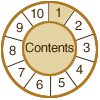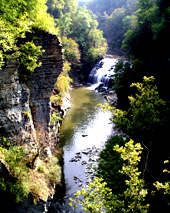

1. Basic Terminology
Key Concepts
digital
images
resolution
pixel dimensions
bit depth
dynamic range
file size
compression
file formats
DYNAMIC RANGE is the range of tonal difference between the lightest light and darkest dark of an image. The higher the dynamic range, the more potential shades can be represented, although the dynamic range does not automatically correlate to the number of tones reproduced. For instance, high-contrast microfilm exhibits a broad dynamic range, but renders few tones. Dynamic range also describes a digital system's ability to reproduce tonal information. This capability is most important for continuous-tone documents that exhibit smoothly varying tones, and for photographs it may be the single most important aspect of image quality.

Dynamic Range: The image on top has a broader dynamic range, but a limited number of tones represented. The lower image has a narrower dynamic range, but a greater number of tones represented. Note the lack of detail in shadows and highlights in the top frame. Courtesy of Don Brown.
|
Reality Check
Answer (check one):
|
© 2000-2003 Cornell University Library/Research Department

